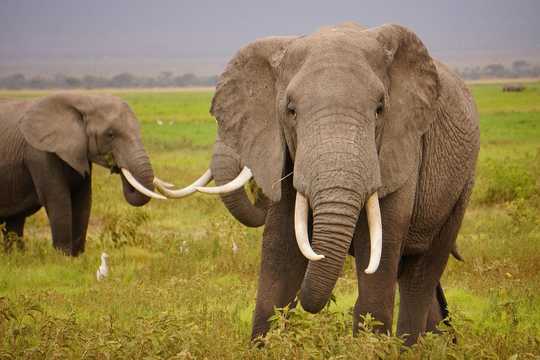
Elephants have long captivated our attention, partly because of their sheer size and majesty. But we’re also struck by their complex behaviour. In some ways, we’re fascinated because this behaviour echoes our most humane feelings. For instance, elephants have repeatedly been observed using tools and grieving their dead.
Their evolutionary history is interesting, too. It parallels humans’ in many ways. Elephant ancestors originated in Africa, just like ours. Their descendants, among them mammoths, went out of Africa to inhabit other continents. And in the process they evolved the largest brain of any land animal. It weighs around 5kg, while our own brains weigh 1.4kg.
But what drove this particular element of elephant evolution? Even though the fossil record of elephant ancestors is rich – with almost 300 species described – we simply haven’t known the answer for a long time. From the earliest species with small brains to the modern elephants with large brains, there was an almost 30 million-year-long gap in our knowledge.
Now, thanks to cutting edge scanning techniques and state of the art statistical reconstruction of ancestral features, we have the answer. A team of scientists from South Africa, Europe and North America – including us – have spent six years reconstructing the first accurate time line of brain evolution in the elephant lineage. The results of this international collaboration have been published in Scientific Reports.
And the answer to this longstanding question? Climate change is a large part of it. A shift in climate, along with other environmental disruptions and the invasion of competitors and new predators all likely played an important role in reshaping ancient elephants’ brains. Knowing this not only solves a long standing scientific mystery. It also means we’ve got a way to understand how modern species might adapt to the current climate crisis.
Climate-linked changes
Our survey revealed that brain size in ancestral elephants increased in two pulses, approximately 26 and 20 million years ago. The encephalization quotient (a measure of relative brain size corrected for body size) doubled during each pulse. This transformed the small brain of early elephant relatives into a large brain comparable in every way to that of modern species.
Noticeably, these two pulses of growth in brain size correspond to periods of substantial environmental disruptions in Africa. Some 26 million years ago, Antarctica was frozen for the first time, which caused a global aridification of the climate. Africa’s dense rain forests turned into savannas and deserts.
The climate then changed again about 20 million years ago to revert to a warmer and wetter African environment. This climatic instability was supplemented by the appearance of a landbridge between Asia and Africa.
Before 20 million years ago, Africa was indeed an isolated continent. But because of continental drift it eventually collided with the Levant (the area encompassing modern day Palestine, Israel, Lebanon, Syria, Jordan and Iraq), enabling the invasion of rival herbivores and new predators from Asia. The invasive fauna included the ancestors of modern-day lion, zebra, rhinoceros, hippopotamus and antelopes. The Great Apes did not exist yet. Some large species died out during this time; the most famous is Arsinoitherium, a rhino-like relative of elephants.
Ancestral elephants had to adapt or go extinct. At that time, they were still relatively small animals, the size of a tapir, with a short trunk only. We hypothesise that a bigger brain enabled more behavioural flexibility: to be more exploratory, to migrate to look for food, to cope with a wider variety of diets (leaves, fruits, grass), and to remember the location of distant waterholes during dry periods, for example. A larger brain may have helped them outsmart competitors and avoid predators.
Body and brain size
Elephants were also helped by the fact that they became so big. Being large opens up a whole new world of advantages: it deters predators and when food resources and water are scarce, a large body can store more fat and water, and a larger gut can digest food more efficiently.
We found that brain size co-evolved tightly with body size in the elephantine lineage. This suggests that the evolution of a big body is not completely independent from a large brain. The elephant’s large brain likely evolved, not only for more behavioural flexibility, but also hand in hand with their large body. This is a cautionary tale about interpreting brain size only in the light of retrospectively applied conjectural needs for greater intelligence.
Simply put, when it’s found that a given lineage’s brain size increased, people jump to the conclusion that this is because the lineage needed to become smarter to survive. But we must not forget that brain size is correlated to many other variables: body size is one example. Gestation length is another (more time in the womb equals a bigger brain). Usually, people think these are side effects of a larger brain, but what if a larger brain was actually the side effect of a bigger body mass? What if natural selection was acting on body size only, and brain size was just a passenger?
Answers to these questions are still pending. But as our work progresses, the picture gets clearer. Thanks to our research it is now evident that environmental disruptions, including changes in climate, and the invasion of competitors and new predators, played an important role in re-shaping the brain of ancestral elephants and their behaviour.![]()
About The Authors
Julien Benoit, Postdoc in Vertebrate Palaeontology, University of the Witwatersrand and Paul Manger, Professor of Comparative and Evolutionary Neurobiology, University of the Witwatersrand
This article is republished from The Conversation under a Creative Commons license. Read the original article.
{vembed Y=BZ2wUXrKqYU}
Related Books
Life After Carbon: The Next Global Transformation of Cities
by Peter Plastrik , John Cleveland The future of our cities is not what it used to be. The modern-city model that took hold globally in the twentieth century has outlived its usefulness. It cannot solve the problems it helped to create—especially global warming. Fortunately, a new model for urban development is emerging in cities to aggressively tackle the realities of climate change. It transforms the way cities design and use physical space, generate economic wealth, consume and dispose of resources, exploit and sustain the natural ecosystems, and prepare for the future. Available On Amazon
The future of our cities is not what it used to be. The modern-city model that took hold globally in the twentieth century has outlived its usefulness. It cannot solve the problems it helped to create—especially global warming. Fortunately, a new model for urban development is emerging in cities to aggressively tackle the realities of climate change. It transforms the way cities design and use physical space, generate economic wealth, consume and dispose of resources, exploit and sustain the natural ecosystems, and prepare for the future. Available On Amazon
The Sixth Extinction: An Unnatural History
by Elizabeth Kolbert Over the last half-billion years, there have been Five mass extinctions, when the diversity of life on earth suddenly and dramatically contracted. Scientists around the world are currently monitoring the sixth extinction, predicted to be the most devastating extinction event since the asteroid impact that wiped out the dinosaurs. This time around, the cataclysm is us. In prose that is at once frank, entertaining, and deeply informed, New Yorker writer Elizabeth Kolbert tells us why and how human beings have altered life on the planet in a way no species has before. Interweaving research in half a dozen disciplines, descriptions of the fascinating species that have already been lost, and the history of extinction as a concept, Kolbert provides a moving and comprehensive account of the disappearances occurring before our very eyes. She shows that the sixth extinction is likely to be mankind's most lasting legacy, compelling us to rethink the fundamental question of what it means to be human. Available On Amazon
Over the last half-billion years, there have been Five mass extinctions, when the diversity of life on earth suddenly and dramatically contracted. Scientists around the world are currently monitoring the sixth extinction, predicted to be the most devastating extinction event since the asteroid impact that wiped out the dinosaurs. This time around, the cataclysm is us. In prose that is at once frank, entertaining, and deeply informed, New Yorker writer Elizabeth Kolbert tells us why and how human beings have altered life on the planet in a way no species has before. Interweaving research in half a dozen disciplines, descriptions of the fascinating species that have already been lost, and the history of extinction as a concept, Kolbert provides a moving and comprehensive account of the disappearances occurring before our very eyes. She shows that the sixth extinction is likely to be mankind's most lasting legacy, compelling us to rethink the fundamental question of what it means to be human. Available On Amazon
Climate Wars: The Fight for Survival as the World Overheats
by Gwynne Dyer Waves of climate refugees. Dozens of failed states. All-out war. From one of the world’s great geopolitical analysts comes a terrifying glimpse of the strategic realities of the near future, when climate change drives the world’s powers towards the cut-throat politics of survival. Prescient and unflinching, Climate Wars will be one of the most important books of the coming years. Read it and find out what we’re heading for. Available On Amazon
Waves of climate refugees. Dozens of failed states. All-out war. From one of the world’s great geopolitical analysts comes a terrifying glimpse of the strategic realities of the near future, when climate change drives the world’s powers towards the cut-throat politics of survival. Prescient and unflinching, Climate Wars will be one of the most important books of the coming years. Read it and find out what we’re heading for. Available On Amazon
From The Publisher:
Purchases on Amazon go to defray the cost of bringing you InnerSelf.comelf.com, MightyNatural.com, and ClimateImpactNews.com at no cost and without advertisers that track your browsing habits. Even if you click on a link but don't buy these selected products, anything else you buy in that same visit on Amazon pays us a small commission. There is no additional cost to you, so please contribute to the effort. You can also use this link to use to Amazon at any time so you can help support our efforts.























